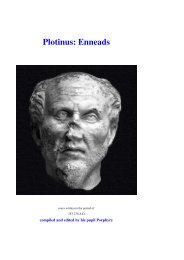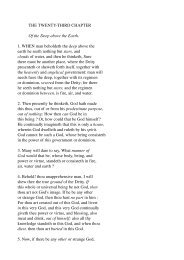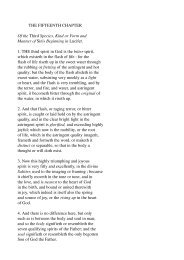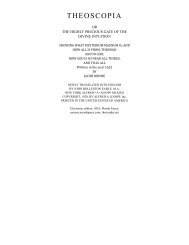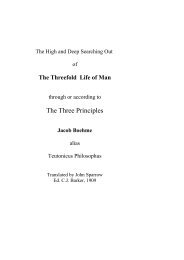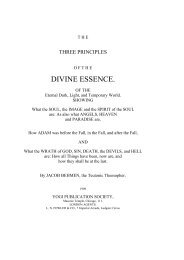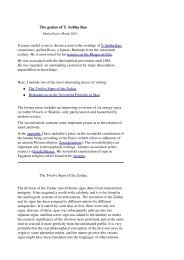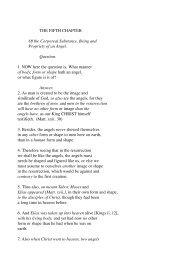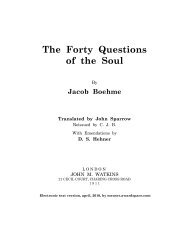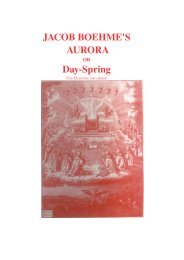Gerald Massey's Lectures - Society in evolution - Awardspace
Gerald Massey's Lectures - Society in evolution - Awardspace
Gerald Massey's Lectures - Society in evolution - Awardspace
Create successful ePaper yourself
Turn your PDF publications into a flip-book with our unique Google optimized e-Paper software.
known on either side, it follows that the Jesus of the Gospels is the Jehoshua of the<br />
Talmud, or is not at all, as a Person. This shifts the historic basis altogether; it antedates<br />
the human history by more than a hundred years, and it at once destroys the historic<br />
character of the Gospels, together with that of any other personal Jesus than Ben-Pandira.<br />
In short, the Jewish history of the matter will be found to corroborate the mythical. As<br />
Epiphanius knew of no other historical Jesus than the descendant of Pandira, it is possible<br />
that this is the Jesus whose tradition is reported by Irenæus.<br />
Irenæus was born <strong>in</strong> the early part of the second century, between 120 and 140 A.D. He<br />
was Bishop of Lyons, France, and a personal acqua<strong>in</strong>tance of Polycarp; and he repeats a<br />
tradition testified to by the elders, which he alleges was directly derived from John, the<br />
"disciple of the Lord," to the effect that Jesus was not crucified at 33 years of age, but<br />
that he passed through every age, and lived on to be an oldish man. Now, <strong>in</strong> accordance<br />
with the dates given, Jehoshua Ben-Pandira may have been between 50 and 60 years of<br />
age when put to death, and his tradition alone furnishes a clue to the Nihilistic statement<br />
of Irenæus.<br />
When the true tradition of Ben-Pandira is recovered, it shows that he was the sole<br />
historical Jesus who was hung on a tree by the Jews, not crucified <strong>in</strong> the Roman fashion,<br />
and authenticates the claim now to be made on behalf of the astronomical allegory to the<br />
dispensational Jesus, the Kronian Christ, the mythical Messiah of the Canonical Gospels,<br />
and the Jesus of Paul, who was not the carnalised Christ. For I hold that the Jesus of the<br />
"other Gospel," accord<strong>in</strong>g to the Apostles Cephas and James, who was utterly repudiated<br />
by Paul, was none other than Ben-Pandira, the Nazarene, of whom James was a follower,<br />
accord<strong>in</strong>g to a comment on him found <strong>in</strong> the Book Abodazura. Anyway, there are two<br />
Jesuses, or Jesus and the Christ, one of whom is repudiated by Paul.<br />
But Jehoshua, the son of Pandira, can never be converted <strong>in</strong>to Jesus Christ, the son of a<br />
virg<strong>in</strong> mother, as an historic character. Nor can the dates given ever be reconciled with<br />
contemporary history. The historical Herod, who sought to slay the young child Jesus, is<br />
known to have died four years before the date of the Christian era, assigned for the birth<br />
of Jesus.<br />
So much for the historic Jesus. And now for the mythical Christ. Here we can tread on<br />
firmer ground.<br />
The mythical Messiah was always born of a Virg<strong>in</strong> Mother--a factor unknown <strong>in</strong> natural<br />
phenomena, and one that cannot be historical, one that can only be expla<strong>in</strong>ed by means of<br />
the Mythos, and those conditions of primitive sociology which are mirrored <strong>in</strong> mythology<br />
and preserved <strong>in</strong> theology. The virg<strong>in</strong> mother has been represented <strong>in</strong> Egypt by the<br />
maiden Queen, Mut-em-ua, the future mother of Amenhept III. some 16 centuries B.C.,<br />
who impersonated the eternal virg<strong>in</strong> that produced the eternal child.<br />
Four consecutive scenes reproduced <strong>in</strong> my book are found pourtrayed upon the <strong>in</strong>nermost<br />
walls of the Holy of Holies <strong>in</strong> the Temple of Luxor, which was built by Amenhept III., a<br />
Pharaoh of the 17th dynasty. The first scene on the left hand shows the God Taht, the<br />
Lunar Mercury, the Annunciator of the Gods, <strong>in</strong> the act of hail<strong>in</strong>g the Virg<strong>in</strong> Queen, and<br />
announc<strong>in</strong>g to her that she is to give birth to the com<strong>in</strong>g Son. In the next scene the God<br />
Kneph (<strong>in</strong> conjunction with Hathor) gives the new life. This is the Holy Ghost or Spirit<br />
that causes the Immaculate Conception, Kneph be<strong>in</strong>g the spirit by name <strong>in</strong> Egyptian. The<br />
natural effects are made apparent <strong>in</strong> the virg<strong>in</strong>'s swell<strong>in</strong>g form.<br />
Next the mother is seated on the mid-wife's stool, and the newborn child is supported <strong>in</strong><br />
the hands of one of the nurses. The fourth scene is that of the Adoration. Here the child is<br />
enthroned, receiv<strong>in</strong>g homage from the Gods and gifts from men. Beh<strong>in</strong>d the deity Kneph,<br />
on the right, three spirits--the Three Magi, or K<strong>in</strong>gs of the Legend, are kneel<strong>in</strong>g and<br />
offer<strong>in</strong>g presents with their right hand, and life with their left. The child thus announced,<br />
<strong>in</strong>carnated, born, and worshipped, was the Pharaonic representative of the Aten Sun <strong>in</strong><br />
Egypt, the God Adon of Syria, and Hebrew Adonai; the child-Christ of the Aten Cult; the



